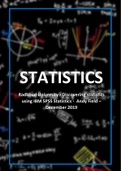Summary
Summary Statistics - Discovering statistics using IBM SPSS- Andy Field
- Course
- Institution
- Book
Summary Discovering Statistics using IBM SPSS - Andy Field - Fifth edition Radboud University Business Administration - Chapter 1,2,7,8,9,10,12,19 - including overview of symbols
[Show more]




